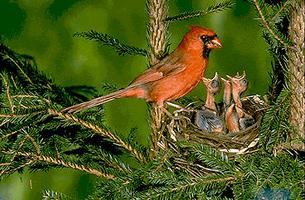The Northern cardinal (Cardinalis cardinalis) is a songbird (Passeriformes) named for the bright red plumage of the male. Cardinals are members of the family Cardinalidae, which also includes rose-breasted grosbeak (Pheucticus ludovicianus), scarlet tanager (Piranga olivacea) and other large-billed seedeaters.
Description
The Northern cardinal is 20-23 cm in length with a wingspan of 30 cm. Sexes are similar in size and shapes but differ in colour. Males are bright red with a black face and throat. Females and juveniles are an olive-buff with red edging. The males' distinctive, loud, slow-whistled song described as "cheer, cheer, cheer" and the common call note, a loud sharp chip, is often heard throughout the year.
Distribution and Habitat
Distribution is throughout eastern North America south of the Canadian Shield continuing into Central America. More common in the south, the first documented record of a Northern cardinal in Canada was in 1849; the first nest was not reported until 1901 at Point Pelee, Ont. They have continued their northern expansion across eastern Canada and are presently found throughout much of the Deciduous forest region of southern Ontario and, in lesser numbers in urban and rural habitats of the Great Lakes-St Lawrence Forest Region from southern Manitoba through Ontario, Québec and the southern Maritimes. Cardinals are non-migratory, year-round residents throughout their range, preferring brushy shrubland, parkland and gardens, often in association with human populations.
Diet
These birds are omnivorous, feeding on a wide variety of seeds, fruits and insects although there is a greater preference for invertebrates during the breeding season. Commonly found at bird feeders, their preferred birdseed is oil-type sunflowers (Helianthus sp.).
Nesting
Cardinals are one of Canada's earliest breeding songbirds beginning nest building as early as late March or early April and may have several nesting attempts throughout the summer and into late September. They are socially monogamous (having only one mate) but recent studies have revealed extra-pair paternity in 9-35% of young. Nests are placed 0.5 to 4.9 m in a tree or shrub. Average clutch size is 2-3 eggs with an incubation period of 11-13 days.

 Share on Facebook
Share on Facebook Share on X
Share on X Share by Email
Share by Email Share on Google Classroom
Share on Google Classroom








